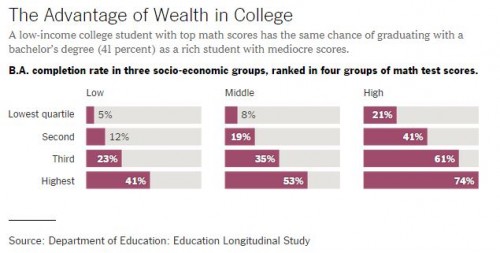There is new research from the National Center for Education Statistics (NCES), written up by Susan Dynarsky at the New York Times Upshot. The striking finding is that poor children in the top quartile on high school math scores have a 41% chance of finishing a BA degree by their late twenties — the same chance as children from the second-lowest quartile in math scores who are high-socioeconomic status (SES). Poor children from the third-highest quartile in high school math have graduation about equal to the worst-scoring children form the richest group. Here’s the figure:
The headline on the figure is misleading, actually, since SES is not measured by wealth, but by a combination of parental education, occupation, and income. (Low here means the bottom quartile of SES, Middle is the 25th to 75th percentile, and High is 75th and up.)
One possible mechanism for the disparity in college completion rates is education expectations. Dynarsky mentions expectations measured in the sophomore year of high school, which was 2002 for this cohort. What she doesn’t mention is how much those expectations changed by senior year. Going to the NCES source for that data (here) I found this chart, which I annotated in red:
Between sophomore and senior year, the percentage expecting to finish a BA degree or more decreased and the percentage expecting to go to two-year college increased, across SES levels. But the change was much greater for lower SES students. So the gap in expecting to go to two-year college between high- and low-SES students grew from 6 to 17 percentage points; that is, from 9% versus 3% in the sophomore year to 22% versus 6% in the senior year.
That’s a big crushing of expectations that happened in the formative years at the end of high school.
Cross-posted at Family Inequality.
Philip N. Cohen is a professor of sociology at the University of Maryland, College Park. He writes the blog Family Inequality and is the author of The Family: Diversity, Inequality, and Social Change. You can follow him on Twitter or Facebook.



Comments 11
Bill R — June 4, 2015
Interestingly these data change and the authors' explanations are NOT supported in NYC when race/nationality is controlled for, especially with Asians.
As it turns out Asian students from poor families disproportionately aced entrance exams to the Bronx HS of Science and Stuyvesant (the city's most elite) which virtually guarantees admittance to good colleges.
So, at least among Asians, INCOME IS NOT THE ISSUE. And we are left a quandary; either accept that income is less a factor then some people claim or set Asians apart as an aberrant class by itself.
I think the correct approach is to consider income to be a surrogate variable for the real explanation, which involves parental oversight.
Unfortunately for some observers my explanation leads one to conclude that poor American families don't provide as good a level of parental oversight as rich ones, and that's a problem for them.
Good luck.
tony — March 17, 2020
That first graph doesnt make any logical sense
Jennifer Pauli — April 21, 2021
Social Class Divides the Futures of High School Students is a new study by William Julius Wilson that examines the effects of class on a student's emotional and psychological well-being. Class divisions are most often perceived in terms of good or evil, and not as abstract as a class divided by wealth or educational achievement. In fact, one of the most common events in bestessayforsale.com, the expulsion from the classroom due to behavioral issues, is not based on ability but on behavior. It is not the school's fault that the student cannot behave; it is the child's own fault.
In this regard, Social Class Divides provides a window into how class relates to self-esteem. The book explores how people who belong to different groups or classes relate to each other and what they have in common.
sunlandedu32 — August 27, 2021
Yeh, I agree with this about the security I was also moving to a different country with my PR visa, the services I use they provided with me the best their services are the best they really help me with my PR visa. I suggest you use this website service called Sunland Education Immigration Consultants.
shan aan — November 22, 2021
Social Class Divides the Futures of High School Students is the main title that we all will be able to explore for them who are in need for that for the very first time ever. I guess resume writers Australia was what there are many in need will like to know.
Auscanz Overseas Education Pvt. Ltd. — July 16, 2022
Auscanz Overseas Education Pvt. Ltd. is one of the leading Organizations, engaged into the Business and Consultancy of Study Visa, IELTS and Spoken English training, Duolingo-English Test. Feel free to contact us for any Visa query Related to Study Visa, Visitor Visa, Tourist Visa, etc
internetsurf — May 2, 2024
The impact of social class on high school students' futures is a complex and important issue. It's crucial to address the disparities that exist and work towards creating a more equitable education system. Lately, linkedin proved to be a valuable platform for discussing and sharing insights on this topic. By raising awareness and advocating for change, we can help ensure that all students have equal opportunities to succeed, regardless of their background.
adam — August 10, 2025
The impact of social class on high school students' futures is a critical issue that shapes opportunities and outcomes in profound ways. Students from higher social classes often have access to better resources, support systems, and networks, which can open doors to college and career success. https://www.reuber-norwegen.de/
adam — December 8, 2025
This is a very thought-provoking read! It highlights how social class can significantly influence educational opportunities and future prospects. An important reminder of the need for equity and support in schools. SpaceXRP Presale Site